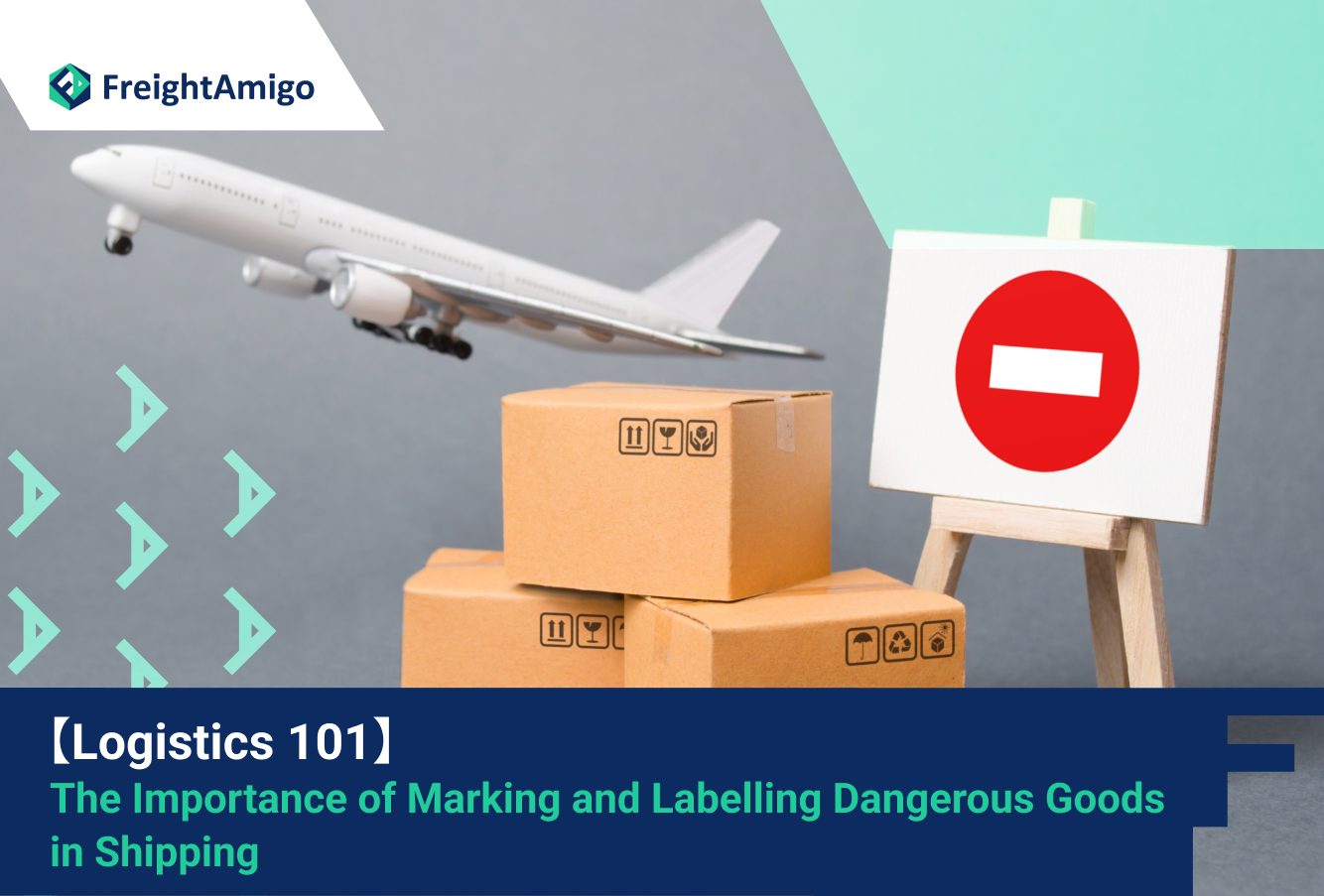January 8th, 2024 Caspian Ng – Marketing Analyst at FreightAmigo
In industries that involve storing or shipping hazardous materials, such as compressed gases, chemicals, fertilizers, or pharmaceutical goods, it is crucial to understand how to safely transport these substances. Properly marking and labelling dangerous goods is essential for ensuring the safety of both human health and the environment during transportation. This article will delve into the significance of marking and labelling dangerous goods, providing valuable insights into the proper handling, storage, and transportation of these materials.
Want to compare the best Express, Air Freight, Sea Freight, Rail Freight & Trucking rates so as to have better control on cost?
Understanding Dangerous Goods
Dangerous goods, also known as hazardous materials or hazmat, are substances that pose risks to human health, property, or the environment during transportation. It is important to recognize that dangerous goods are more common in our daily lives than we might realize. In the United States alone, over three billion tons of these materials are shipped annually. To protect human health and property, proper handling, shipping, and storage procedures must be followed for dangerous goods.
Types of Dangerous Goods Labels
The National Code of Federal Regulations classifies dangerous goods into nine different classes, each requiring specific dangerous goods labels. These classes include:
1. Explosives: This category encompasses substances or devices that are designed to explode or have internal chemical reactions that make them explosive. Examples include fireworks, gunpowder, and airbag inflators.
2. Gases: Gases are divided into three categories. Flammable gases ignite at concentrations of 13% or less in air and have a flammable range of at least 12%. Non-flammable, non-toxic compressed gases include substances like fire extinguishers, carbon dioxide, and nitrogen. Poisonous gases, such as hydrogen sulfide or hydrogen cyanide, are toxic to humans during transportation.
3. Flammable Liquids: Liquids with flashpoints below 60°C (140°F) or flashpoints at or above 37.8°C (100°F) are considered flammable or combustible. Examples include gasoline, camp fuels, paint, and ethanol.
4. Flammable Solids: This category includes materials that are combustible during ignition under normal conditions. Flammable solids are further divided into four divisions based on their specific properties.
5. Oxidizing Substances and Organic Peroxides: Oxidizing materials release oxygen or other oxidizing substances and can react chemically to oxidize combustible materials. These substances are divided into two categories: oxidizing substances and organic peroxides.
6. Poisons and Infectious Substances: Toxic substances are further divided into poisons and infectious substances. Poisons are hazardous due to their oral, dermal, or inhalation toxicity. Infectious substances include items like used needles or blood samples that could potentially spread diseases.
7. Radioactive Materials: Radioactive materials release radionuclides during decay and include substances like radioactive medicines, X-ray machines, and smoke alarms.
8. Corrosives: Corrosives are highly reactive substances that cause damage to human tissue. Examples include most acids, wet and NiCad batteries, and mercury thermometers.
9. Miscellaneous Hazardous Materials: This category encompasses hazardous materials that do not fall under the previous classifications. Examples include dry ice, engines, lithium batteries, and ammonium nitrate fertilizers.
The Difference Between Marking and Labelling
While both marking and labelling play crucial roles in identifying dangerous goods, they serve slightly different purposes. Dangerous goods transport labels communicate the primary hazards posed by the materials, allowing individuals handling them to quickly identify any potential risks. These labels use colors, codes, and pictograms such as hazard symbols or handling labels. Transport labels for dangerous goods must be clearly printed on or affixed to the package’s surface, excluding the bottom, and placed near the shipping marking. They provide instructions on how to transport, handle, and store dangerous goods.
On the other hand, marking provides more specific information about the hazards posed by dangerous goods. It includes a descriptive name, the UN/ID number, the full names and addresses of the shipper and recipient, instructions, cautions, and weight. Specific dangerous goods require specific marks, so it is essential to review the marking requirements. Marks must meet certain criteria to effectively communicate the substance’s hazards. They should be durable, in plain English, clearly printed or affixed to the package’s exterior, displayed on a background of sharply contrasting color, unobscured by other labels or attachments, and located away from other markings that could reduce their effectiveness.
Safely Storing and Transporting Dangerous Goods
To safely transport dangerous goods on U.S. roads and properly store them, it is crucial to follow specific guidelines. The first step is to identify the material on the OSHA Safety Data Sheet, which provides information about the substance’s properties and potential hazards. The Safety Data Sheet also includes instructions for safely transporting hazardous materials, such as proper shipping names and packing groups.
Additionally, consulting the Hazardous Materials Table can help you identify any special provisions or exceptions for different hazardous goods. Correctly classifying the hazards associated with a product is crucial, as all other shipping requirements will be based on this classification. For international shipments across the ocean, understanding the United Nations International Maritime Organization’s International Maritime Dangerous Goods (IMDG) code is essential. This code classifies dangerous goods into nine categories and provides regulations for handling different types of dangerous goods. It helps crew members identify and classify dangerous goods accurately, ensuring safe handling and stowage. Furthermore, IMDG labeling assists the crew in determining the appropriate response in case of an incident.
After identifying the hazardous material, selecting the appropriate packaging is crucial. If performance packaging is required, strictly follow the manufacturer’s instructions to ensure the proper containment of the hazardous material. Apply the necessary dangerous goods hazard labels and markings according to the class of dangerous goods and the specific requirements for your shipment. Finally, prepare a shipping paper before entrusting your package to the carrier of your choice.
Proper storage of hazardous goods is equally important before, during, and after transportation. These materials should be stored in closable cabinets with a front edge lip, away from loading docks or areas with high traffic. Best practices include storing hazardous goods in a separate anti-spill room with an above-ground door to contain any spilled materials. Furthermore, only qualified individuals should handle dangerous substances.
Conclusion
Marking and labelling dangerous goods are crucial steps in ensuring the safe handling, shipping, and storage of hazardous materials. Understanding the different classes of dangerous goods and the corresponding labels is essential for identifying potential risks. By following proper procedures and guidelines, we can safeguard human health and protect the environment during the transportation of dangerous goods.
There are different options for cargo transportation. If you want to choose the most convenient and suitable solution, it is best to have the full support of logistics experts! If you are planning to ship goods overseas, please go to the FreightAmigo page for inquiries.
===
Read More:
Guide to Tariffs in Hong Kong | Things You Need to Know
===
If you have any inquiries on logistics/supply chain, feel free to contact FreightAmigo now:
Chat with us online OR
Phone : +852 28121686
WhatsApp: +852 27467829








































